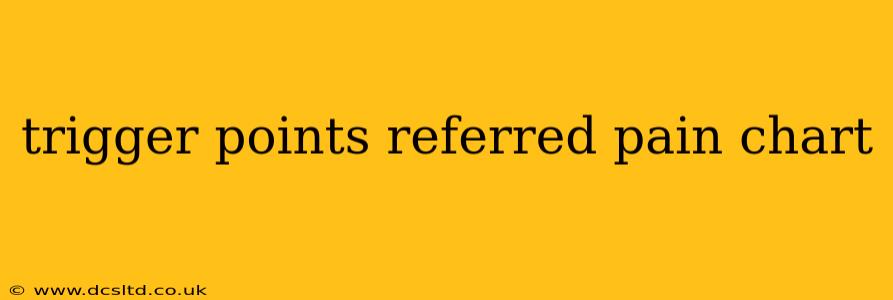Muscle pain isn't always localized. Often, pain originating from a specific trigger point—a hyperirritable spot in a taut band of skeletal muscle—can radiate to seemingly unrelated areas of the body. This phenomenon, known as referred pain, can make diagnosing the root cause of pain challenging. Understanding trigger points and their referred pain patterns is crucial for effective treatment. This article will explore the concept of trigger points and provide a general overview of referred pain patterns. Remember, this information is for educational purposes only and should not replace professional medical advice. Always consult a healthcare professional for diagnosis and treatment of pain.
What are Trigger Points?
Trigger points are small, hyperirritable areas within a muscle that are tender to the touch. When palpated (pressed), they often cause a localized twitch response in the muscle and can refer pain to other areas of the body. These points are often associated with muscle tightness, knots, and restricted movement. The exact mechanisms behind trigger point formation are still being researched, but factors such as muscle overuse, injury, poor posture, and stress are often implicated.
What is Referred Pain?
Referred pain is the perception of pain in a location other than the source of the pain. This is a complex phenomenon involving the nervous system. The nerves from different parts of the body often converge on the same spinal cord segments. This convergence can lead to confusion in the brain's interpretation of pain signals, resulting in the sensation of pain in an area distant from the actual trigger point.
How Do I Use a Trigger Point Referred Pain Chart?
There isn't one single, universally accepted trigger point referred pain chart. The patterns of referred pain can vary depending on the individual, the specific muscle involved, and the intensity of the trigger point. However, many resources, including anatomical texts and clinical guides, provide illustrations of common referred pain patterns for various muscles. These charts typically show the location of the trigger point and the areas where pain is commonly referred.
It's important to note that the pain referral patterns shown on these charts represent common patterns, not absolute rules. Individual experiences may differ.
How to Interpret a Trigger Point Chart:
- Identify the Muscle: First, pinpoint the muscle you suspect is causing the pain.
- Locate the Trigger Point: Charts usually show the exact location of common trigger points within that muscle.
- Observe the Referred Pain Area: The chart will then illustrate the areas where pain may be referred from that specific trigger point.
Example: A trigger point in the upper trapezius muscle (located in the upper back and neck) might refer pain to the head, neck, and even the shoulder blade.
Why Do My Trigger Points Cause Referred Pain?
This question delves into the complex neurophysiology of pain. In short, the sensory nerves from the affected muscle share pathways in the spinal cord with nerves from other areas. When a trigger point is activated, the signals traveling along these shared pathways are interpreted by the brain as pain originating from those other areas. The overlapping sensory input from different areas confuses the brain's ability to accurately localize the pain.
Can I Treat Trigger Points Myself?
While some self-treatment options might offer temporary relief, it is essential to consult a healthcare professional for accurate diagnosis and effective treatment. Self-treatment options that may provide some relief include:
- Self-massage: Gently massaging the affected area may help relieve muscle tension and improve circulation.
- Stretching: Regular stretching can help improve muscle flexibility and reduce tightness.
- Heat or ice: Applying heat or ice packs can help reduce inflammation and pain.
However, incorrect self-treatment could worsen the condition. A healthcare professional can provide a tailored treatment plan based on your specific needs, which might include physical therapy, dry needling, or other specialized techniques.
What are Common Trigger Point Locations and Referred Pain Patterns?
This section would ideally include visuals (which cannot be directly implemented in this Markdown format). However, I can provide textual examples:
- Upper Trapezius: Referred pain often to the head, neck, and shoulder.
- Temporalis (Temple Muscle): Pain often referred to the temple, eye, and forehead.
- Pectoralis Minor: Can refer pain to the chest, shoulder, and arm.
- Gluteus Medius: Referred pain commonly felt in the hip, buttock, and thigh.
This list is not exhaustive, and many other muscles have associated trigger points and referred pain patterns. This information highlights the complexity of pain referral and the importance of professional diagnosis.
Disclaimer: This information is for educational purposes only and is not intended as a substitute for professional medical advice. Consult with a healthcare professional for diagnosis and treatment of pain.
